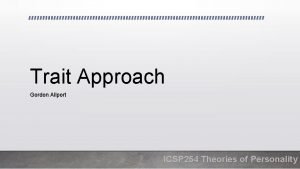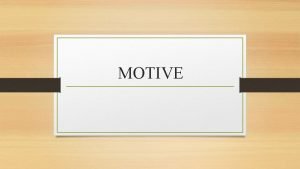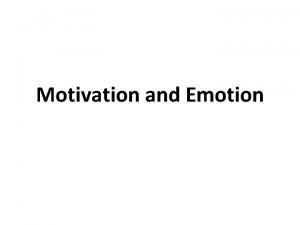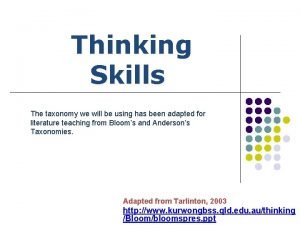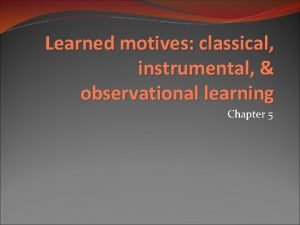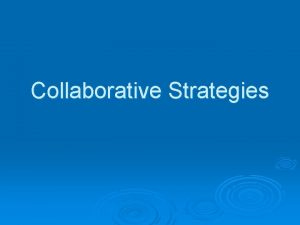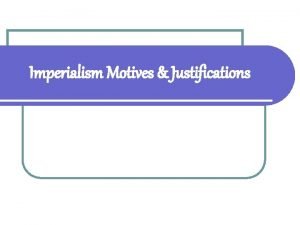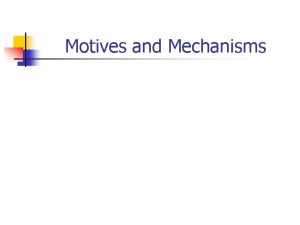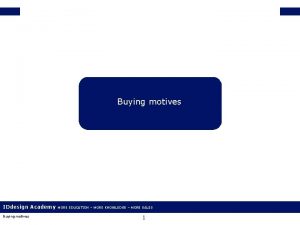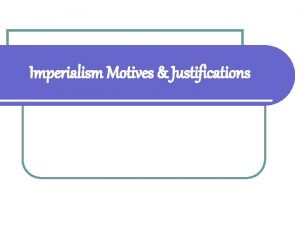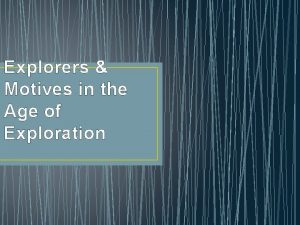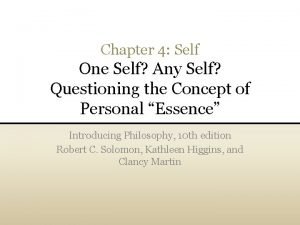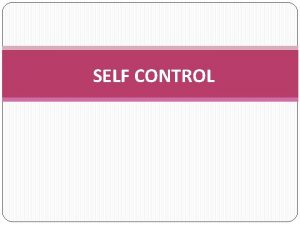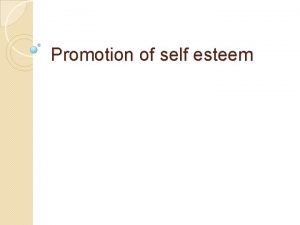Chapter 6 The Key Self Motives The Key































- Slides: 31

Chapter 6 The Key Self Motives

The Key Self Motives �Consistency �Esteem �Presentation �Growth

Consistency �Cognitive dissonance: The Need to Justify Our Actions (micro level) �A drive or feeling of discomfort originally defined as being caused by holding two or more inconsistent cognitions �Subsequently defined as being caused by performing an action that is discrepant from one’s customary, typically positive self-conception

Why do we experience it? �We have a need to preserve a stable, positive selfimage. �We like to believe that we are reasonable, moral and smart �We often believe that we are more ethical, attractive, competent, leaders, drivers, and judges of character than others

How do you reduce dissonance? � 1. Change your behavior. � 2. Justify or attempt to justify your behavior by - changing a cognition. �- adding new cognitions (rationalizing) � 3. Trivialize the inconsistent cognitions

Free-choice Paradigm �Post-decision dissonance �Spread the alternatives �Also search for information that confirms your decision or choice.

Post-decision Dissonance �The one you chose becomes more desirable and the one you rejected less desirable in your mind. (Could this contribute to brand loyalty? ) �How do we change our thoughts? �Alter the importance of characteristics �Alter levels of attractiveness �The more important the decision, the greater the dissonance. �Racetrack study (in text) – People who had already placed bets were much more confident of winning. �Irrevocability of the decision. Harvard photography study (text) People who chose a photograph to keep liked it much more under the conditions that it could not be exchanged.

Induced Compliance Paradigm �Festinger & Carlsmith �Participants performed a task and rated it. �Participants offered either $1. 00 or $20. 00 to say that a boring task was interesting. �Those offered $1. 00 changed their ratings.

Factors Affecting the Magnitude of Dissonance �Weak external justification �Choice – counterattitudinal advocacy �Commitment – more commitment, more dissonance �Attitude change is one way of resolving dissonance �Foreseeable aversive consequences – higher chance, more dissonance �Cultural influences – in the situations causing dissonance

Higher self-esteem – Greater dissonance �Have a higher standard to live up to �Self-standards �Perceived self-control �Positive and negative self perceptions �Self-awareness

Applications of Dissonance Theory �Induced hypocrisy (counterattitudinal advocacy) �Effort justification: �We love what we suffer for. (Why hazing? ) � Minimal deterrence (parenting advice) �Use minimal punishment. Just enough helps them lost the desire to do the behavior.

The Hypocrisy Paradigm �Aronson, et al. (1990 s) � 2 groups of students did essays describing the dangers of AIDS and advising the regular use of condoms. �Group 2 recited the essays in front of a camera and were told that the videos would be shown to HS students. �Half of each group made a list of times they had failed to use condoms. �Hypocrisy induction: group 2 who had made a list and also a video � They had the best indication of practicing what they preached, i. e. , they bought condoms and reported that they used them

Being rational vs. rationalizing �In short, we do not process information objectively. �We remember plausible arguments that agree with our position, but forget implausible (silly) ones. �We remember implausible arguments that disagree with our position, but not plausible ones.

Self-consistency at the Macro Level �Self-concept clarity �Seek out others and social situations that confirm the way they view themselves – self-verification �Nostalgia helps us cope. �Self-complexity – number of aspects of the selfconcept �Self-narrative: your life story �Basis for effective action �Psychological security

The decision to behave immorally. �When you engage in a behavior you believe to be wrong or immoral, you feel badly about yourself. Often people reduce this dissonance by changing their moral values to declare the behavior not so bad or immoral after all. In more religious terminology, you feel guilty, and rather than changing your behavior (repentance), you decide to change your moral code. One of the most popular rationalizations for this is “everybody’s doing it, ” or “nice girls do” as opposed to “nice girls don’t. ” Over time this process will lead the morals of entire groups of people to the lowest common denominator. Do you suppose this is how we came from a Christian culture to a culture of sexual promiscuity? Judson Mills created a situation among 6 th graders where it was easy to cheat and almost impossible to win without cheating. There were prizes for winning, and Mills made it appear that it would be difficult to get caught cheating. Some students cheated and others did not. The next day, those who had cheated were more lenient toward cheating and those who had not were more strict.

The effect on personal values. �Incremental processes. �Generally people will not behavior in a way strongly inconsistent with their values; they are more likely to act just a little differently. �However, this causes dissonance that needs to be resolved. One way to resolve this is by changing attitudes, values, morals, etc. just slightly. �However, from the new position of the value system, further discrepant behaviors can/will be reached. When the dissonance of doing that is resolved, the value system moves again, etc.

Dissonance in the Brain �Harmon-Jones (2010) �f. MRI technology �Striatum and other pre-frontal cortex areas involved with planning and decision-making �Weston et al. (2006) �As dissonant information is processed, the reasoning areas of the brain shut down and the emotional areas light up. As consonance is restored, pleasure centers light up. �“Dissonance can make your brain hurt. ”

Self-Justification in Everyday Life �What do you do when you just made a bad decision? �Group memberships �Self-help seminars �Health and fitness products �Psychotherapy �You can use an external justification. (Form of rationalization. ) �You can use an internal justification. Change something about yourself.

Counter attitudinal Advocacy �Arguing the side of the issue with which you do not agree. (Internal or External Justification) �Classic study: Festinger & Carlsmith (1959) and the boring task �Participants were paid either $1. 00 or $20. 00 to lie. Those who were paid only $1. 00 tended to believe what they said. �Other Contexts: �Marijuana legalization; police force during demonstrations; race issues; eating disorders

Justifying Acts of Kindness �The Ben Franklin Effect �Get someone to do you a favor, and they will like you more. �Do a favor for someone, and you will like them more. �(People who decline to help lower their opinions of those they could have helped. )

Punishment & Self-Persuasion �Sometimes external punishment is sufficient. �Insufficient punishment is when the punishment is mild and should not be enough to keep the person from doing what they otherwise wanted to do. If the person does not engage in the activity, he/she must come up with internal justification – usually the devaluing of the activity or object. This is called self-persuasion and is relatively permanent . � Aronson & Carlsmith (1963): the forbidden toy study. Children were threatened with either mild or severe punishment for playing with the toy. Those threatened with mild punishment later rated the toy as less desirable (internal justification) than those who had been threatened with severe punishment(external justification). � Summary. Large rewards and threats of large punishments are external. They are the best for immediate compliance, but decrease the likelihood of permanent attitude change.

Maintaining/Defending Self-Esteem �Self-serving attributions �Self-handicapping �Better-than-average effect �Projection: see others as having same traits & behaviors �Symbolic self-completion: compensating for your shortcomings in a shallow way (symbols, going public, etc. ) �Compensation: inflating your value in an unrelated domain �Self-affirmation: bring to mind another valued aspect of themselves

Social Comparison & Identification �Comparison with yourself. Are you better now than you used to be? �Basking in reflected glory. Are you affiliated with a successful person or group? �Self-evaluation maintenance model. Is the comparison relevant?

� 1. Name one of the key self-motives. � 2. What is cognitive dissonance? � 3. Why do we experience it? � 4. Name 3 ways to reduce dissonance. � 5. What is induced hypocrisy or counter attitudinal advocacy? � 6. Is rationalizing rational? � 7. What effect does self justification have on personal values? � 8. What does a decision to behave morally do to moral beliefs? � 9. What does effective but insufficient punishment lead to? � 10. How do you justify acts of kindness? What is this called?

Self-Presentation �What is the dramaturgic al approach? �Where do we learn our scripts? �What does the social context define? �Roles, fellow performers & audience

Is your performance sincere? �Most performances are rote and automatic. �Cynical (contrived) performances are conscious, deliberate attempts to create a certain impression.

Strategies �Honing an image �Self-promotion (boasting) �Supplication (revealing a weakness) �Ingratiation (flattery) �Imitation �Intimidation (image of power/strength)

Audience Segregation �Play different roles and create different images for different audiences �Lying

Individual Differences �Self-monitoring �High self-monitors are social chameleons and are better at cynical performances. �Spotlight effect – belief that others are more focused on us than they actually are �Also leads people to overestimate how much others can know of their internal thoughts and feelings (illusion of transparency) �A good example is the “Telltale Heart. ”

Fundamental Motive for Self-preservation �Protect self-esteem or self-image �Protect the meaningfulness of social interactions �Self-improvement and personal growth

Maximizing Personal Growth �Pursue goals that support core needs. �Full engagement or flow (challenging tasks) �Act mindfully �Expand your mind/explore the world �See things as a challenge rather than a threat �Foster positive moods
 The real self vs ideal self
The real self vs ideal self Propium allport
Propium allport Leading motives quest
Leading motives quest Leading motives quest
Leading motives quest Security investigation meaning
Security investigation meaning The patterns of feelings motives and behavior
The patterns of feelings motives and behavior Roanoke island mystery
Roanoke island mystery Incentive to act
Incentive to act Types of motives in psychology
Types of motives in psychology Primary and secondary emotions chart
Primary and secondary emotions chart Patronage buying motives
Patronage buying motives Motives and functions of a business
Motives and functions of a business Uncovering motives hots
Uncovering motives hots Vasco nunez de balboa motives for exploration
Vasco nunez de balboa motives for exploration Motives concealer
Motives concealer Learned motives
Learned motives Interior motives flemington nj
Interior motives flemington nj Chapter 9 motivation and emotion
Chapter 9 motivation and emotion Patronage motives
Patronage motives Motives for imperialism
Motives for imperialism Ponce de leon motives for exploration
Ponce de leon motives for exploration Motives for colonizing plymouth
Motives for colonizing plymouth Motives of merger
Motives of merger Motives of merger
Motives of merger Africa 1890
Africa 1890 Robert de la salle personal background
Robert de la salle personal background New imperialism vs old imperialism
New imperialism vs old imperialism Bringing ivory to the wagons in south africa
Bringing ivory to the wagons in south africa Years of exploration juan ponce de leon
Years of exploration juan ponce de leon John cabot motives
John cabot motives Types of collaborative arrangements
Types of collaborative arrangements Triangular trade
Triangular trade

